Agricultural Adjuvants Market Overview:
The global agricultural adjuvants market size was valued at $3.5 billion in 2021, and is projected to reach $6.4 billion by 2031, growing at a CAGR of 6.1% from 2022 to 2031.
Agricultural adjuvants are type of additives that are added to crop protection products or agrochemicals to improve overall performance. Drift control agents, stickers, wetting agents, water conditioners, and penetrant are types of adjuvants available in the market.
Key Market Insights
- By Product Type, The activators segment led the market in 2021 and is projected to grow at a 6.4% CAGR.
- By Application, Herbicide application dominated the market in 2021 and is expected to grow at a 6.2% CAGR.
- By Region, Asia-Pacific agricultural adjuvants market held 37% share in 2021 and is expected to grow at a 7.2% CAGR.
Market Size & Forecast
- 2030 Projected Market Size: USD 6.4 Billion
- 2020 Market Size: USD 3.5 Billion
- Compound Annual Growth Rate (CAGR) (2021-2030): 6.1%
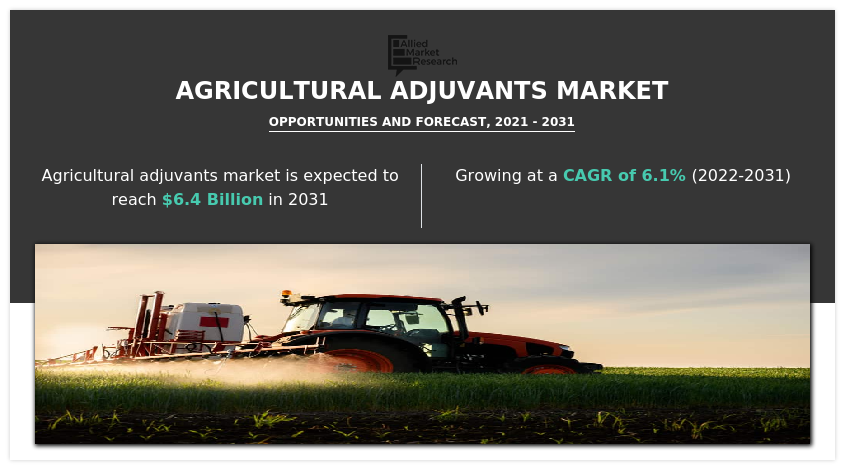
How to Describe Agricultural Adjuvants
Agricultural adjuvants are substances added to crop protection products such as pesticides, herbicides, fungicides, and fertilizers to enhance their effectiveness. These adjuvants do not have any pesticidal activity of their own but work by improving the performance of the active ingredients in agrochemical formulations. They increase the adhesion, spread, and penetration of the active chemicals onto the plant surface, ensuring better uptake and distribution. Adjuvants also help reduce the volatility and drift of sprays, minimize the impact of environmental factors, and optimize the application of agrochemicals under varying field conditions.
What factors are influencing the Market Dynamics
There is an increase in crop yield and productivity, as these additives enhance the effectiveness of agrochemicals, including pesticides and herbicides. With the growing pressure on farmers to produce more food to meet global demand, adjuvants play a critical role in improving the penetration, adhesion, and spread of pesticides and herbicides, making them more efficient and reducing the amount needed. This leads to better crop protection, higher yields, and more sustainable farming practices, thus boosting the adoption of agricultural adjuvants in both conventional and organic farming sectors.
Activators are adjuvants that are used to alter particle size, viscosity, evaporation rate, and other characteristics of agrochemicals. Surfactants, wetting agents, and oils are three types of activators that are available in the market. Surfactant agricultural adjuvants are used to alter the surface tension of agrochemicals, enhance surface contact, minimize water runoff, and enhance leaf penetration. Non-ionic (NIC) are proven to minimize water molecule surface tension that in turn helps water droplets to reach large surface area in leaves. However, the use of NIC is restricted to 1-2 pints per 100 gallon of spray solution to improve the growth of crops and allow large amount of water droplets to reach maximum leaf surface area. On the other hand, anionic surfactant adjuvants are used to enhance foaming and spreading characteristics of agrochemicals. Pesticides, herbicides, or other agrochemical help to enhance the growth of crop and eliminates growth of pests and other crop harming disease. However, agrochemicals are used in the form of solutions and sprayed over the crops. Addition of surfactant adjuvants along with these agrochemical solutions enables the sprayed solution to spread effectively and in turn minimizes the surface tension of agrochemical solution, thereby effectively helping the solution to reach the target area. For instance, spraying of pesticides along with surfactant adjuvants enables the solution to spread across target weed leaf by increasing contact of weed leaf, which in turn enhances absorption capability. All these are the major agricultural adjuvants market growth factors.
However, tank mix adjuvants tend to impart negative effect on the non-target species, thereby hampering the crop production. Moreover, toxicity associated with use of agrochemicals is another considerable factor that is anticipated to hamper the market growth. Toxicological risks associated with use of agricultural spray adjuvants, such as organosilicone surfactants, is anticipated to hamper the market growth. Use of agricultural adjuvants along with pesticide formulation tend to effect negatively on the non-target organisms that in turn increases the risk of crop damage. Moreover, several studies suggest and proved the negative effect of agricultural adjuvants on mammals and human body cells. This factor is anticipated to hamper the market growth.
On the contrary, growing population has increased the demand for food and other fiber supplements globally. Coupled with growing demand for high agricultural yield, manufacturers across the globe are trying to launch innovative crop protection products that tend to maximize the crop yield. This in turn, has escalated the demand for adjuvant technology that strives to enhance the efficiency of crop protection products. In addition, key-players in the agricultural adjuvants market are launching new products, there by escalating the demand for agricultural adjuvants in the global market. Moreover, industrialization trend towards development of advanced adjuvant molecules and formulation technology that includes multi-components and multi-functional adjuvants with diverse agrochemical compatibility is another considerable factor anticipated to offer new opportunities. In addition, key-players in the agricultural adjuvants market are incorporating use of green chemistries for formulating eco-friendly adjuvant products for use in the agrochemical industry. For instance, modified sugar, such as alkyl polyglucoside tend to have surfactant property, making them viable to be used as spreader or sticker agricultural adjuvant. Alkyl polyglucoside is gaining importance owing to its organic origin and biodegradability.
Agricultural Adjuvants Market Segment Review:
The agricultural adjuvants market is segmented on the basis of product type, utilization type, application, and region. On the basis of product type, the market is categorized into activators, spray modifiers, and utility modifiers. On the basis of utilization type, the market is divided into tank-mix adjuvants and in-can adjuvants. By application. The market is segmented into pesticides, herbicides, insecticides, and others. Region-wise, the market is studied across North America, Europe, Asia-Pacific, and LAMEA.
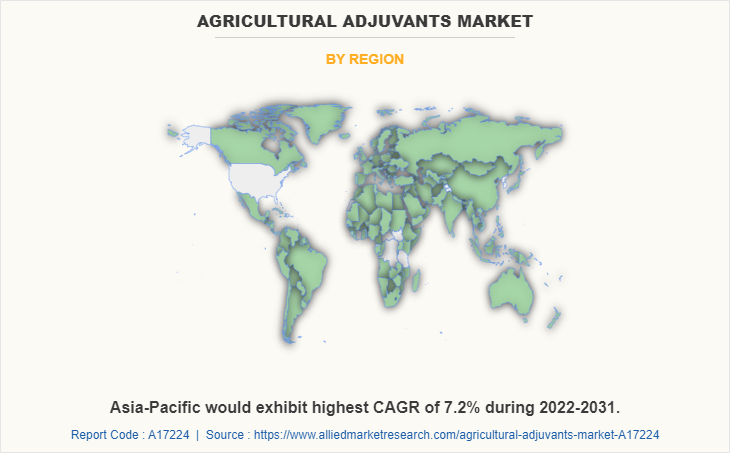
Agricultural Adjuvants Market By Region
The Asia-Pacific agricultural adjuvants market accounted for 37% of the global agricultural adjuvants market share in 2021, and is projected to grow at the highest CAGR of 7.2% during the forecast period. The India agriculture industry plays an important role in the economy and half of the livelihood is dependent on the agriculture sector. In addition, coupled with agricultural resources in term of size & diversity is another considerable factor driving the growth of the agriculture industry across India. Moreover, India is the largest producer of spices, cereals, pulses, and jute. Growing demand for staple food and other food products has pushed the need for high crop yield. Despite the support from governmental and private organization to support the agricultural production, factors such as fragmented landholding, low productivity, lack of irrigation facilities, and low awareness regarding use of agrochemicals limit the growth of the agricultural industry. Adjuvant-based pesticides are proven to facilitate and improve emulsifying characteristic, dispersion, wetting, and modifies other surface properties of the spray liquid.
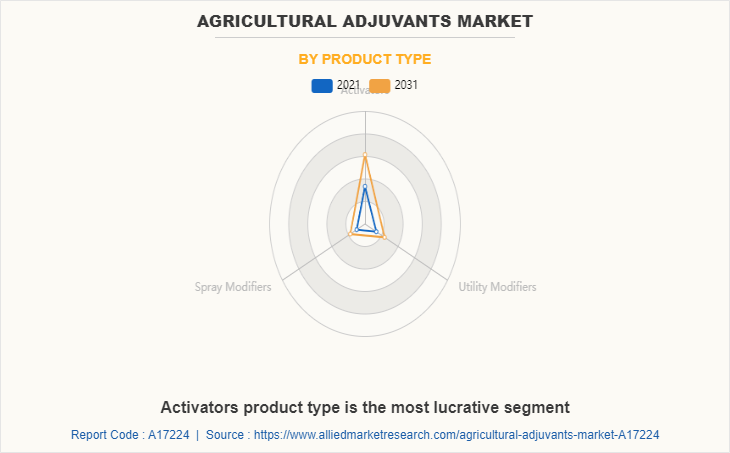
Agricultural Adjuvants Market By Product Type
In 2021, the activators segment was the largest revenue generator, and is anticipated to grow at a CAGR of 6.4% during the forecast period. Anionic surfactant adjuvants are used to enhance foaming and spreading characteristics of agrochemicals. Pesticides, herbicides, or other agrochemical help to enhance the growth of crop and eliminate growth of pests and other crop harming disease. However, these agrochemicals are used in form of solutions and sprayed over the crops. Addition of surfactant adjuvants along with these agrochemical solutions enables the sprayed solution to spread effectively and in turn, minimizes the surface tension of agrochemical solution, thereby effectively helping the solution to reach the target area. For instance, spraying of pesticides along with surfactant adjuvants enables the solution to spread across target weed leaf by increasing contact of weed leaf, which in turn enhances absorption capability.
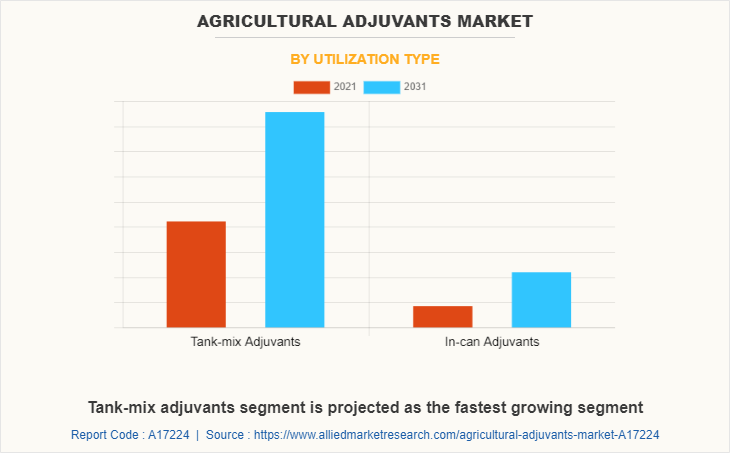
Agricultural Adjuvants Market By Utilization Type
In 2021, the tank-mix adjuvants segment was the largest revenue generator, and is anticipated to grow at a CAGR of 6.3% during the forecast period. Tank-mix adjuvants are type of adjuvants that are added separately into the spray tank along with use of other agrochemicals. Tank-mix adjuvants are capable of increasing and enhancing the performance of agrochemicals or plant protection products. These adjuvants are proven to enhance retention, liquid droplet spreading, wetting of sprayed agrochemicals, and penetration of agrochemicals.
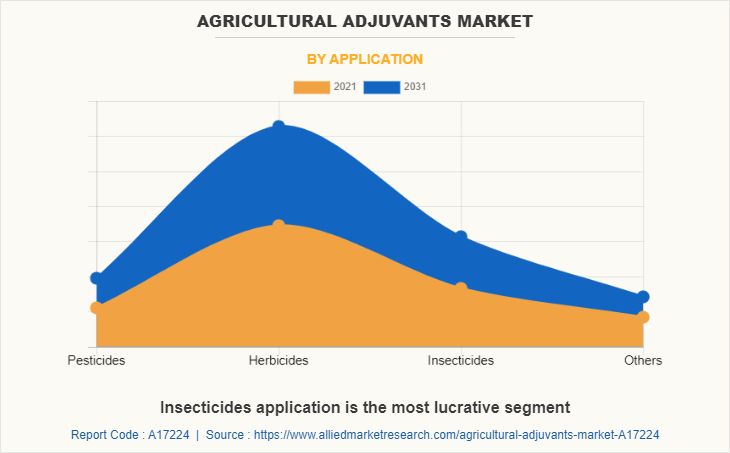
Agricultural Adjuvants Market By Application
By application, the herbicide application dominated the global market in 2021, and is anticipated to grow at a CAGR of 6.2% during the forecast period. Herbicide adjuvant is a type of additive that is envisioned to improve overall effectiveness of an herbicide. However, addition of adjuvants is not required with some herbicides and some herbicides needs addition of adjuvants to enhance the performance. Herbicide products available in the market have labels attached with product that disclose the use of adjuvants with the product. Most of the adjuvants available in the market are designed and proven to help herbicides to stick, cover, and penetrate the leaves reaching the target area effectively. According to the Australian Pesticide and Veterinary Medicine Authority, herbicide adjuvants are used mainly to improve product efficiency and improve ease of herbicide application. Wetter/spreaders, stickers, penetrants, extenders, and humectants are type of adjuvants that are used to enhance the herbicide product efficiency. On the other hand, acidifying/buffering agents, anti-foaming/de-foaming agents, compatibility agents, drift control agents, dyes, and water conditioner are types of adjuvants that are used to ease the use and application of herbicides.
Which are the Leading Companies in Agricultural Adjuvants
The major players operating in the global agricultural adjuvants market. These players have adopted product launches, joint ventures, partnerships, and expansion of the production capabilities to meet the future demand for the agricultural adjuvants industry.
BASF SE
Corteva
Croda International Plc
Evonik Industries
GarrCo Products Inc.
Helena Agri-Enterprises LLC
Loveland Products Inc.
Nufarm, Solvay Inc.
WinField Solutions LLC.
What are the Key Benefits For Stakeholders
- This report provides a quantitative analysis of the market segments, current trends, estimations, and dynamics of the agricultural adjuvants market analysis from 2021 to 2031 to identify the prevailing agricultural adjuvants market opportunities.
- The market research is offered along with information related to key drivers, restraints, and opportunities.
- Porter's five forces analysis highlights the potency of buyers and suppliers to enable stakeholders make profit-oriented business decisions and strengthen their supplier-buyer network.
- In-depth analysis of the agricultural adjuvants market segmentation assists to determine the prevailing market opportunities.
- Major countries in each region are mapped according to their revenue contribution to the global market.
- Market player positioning facilitates benchmarking and provides a clear understanding of the present position of the market players.
- The report includes the analysis of the regional as well as global agricultural adjuvants market trends, key players, market segments, application areas, and market growth strategies.
Agricultural Adjuvants Market Report Highlights
| Aspects | Details |
| By Product Type |
|
| By Utilization Type |
|
| By Application |
|
| By Region |
|
| Key Market Players | Evonik Industries, GarrCo Products Inc., Solvay Inc., WinField Solutions LLC, Loveland Products Inc., Corteva, BASF SE, Nufarm, Helena Agri-Enterprises LLC, Croda International Plc |
Analyst Review
The global agricultural adjuvants market is expected to exhibit high growth owing to its use in pesticides, herbicides, and insecticides. Water solubility of pesticides was the major concern in the early stage. However, new production technologies and product development have overcome water solubility problem of pesticides. However, presence of waxy surface on insects, fungi, and plant makes water-soluble pesticides difficult to reach the target area. To overcome this problem, adjuvants are being added into pesticide spray formulation. Herbicide adjuvant is a type of additive that is envisioned to improve the overall effectiveness of an herbicide. However, addition of adjuvants is not required with some herbicides and some herbicides needs addition of adjuvants to enhance the performance. Herbicide products available in the market have labels attached with product that disclose the use of adjuvants with the product. Most of the adjuvants available in the market are designed and proven to help herbicides to stick, cover, and penetrate the leaves reaching the target area effectively. According to Australian Pesticide and Veterinary Medicine Authority, herbicides adjuvants are used mainly to improve product efficiency and improve ease of herbicide application.
In addition, incorporation of adjuvants with insecticides allows maximum performance of insecticides in cold weather condition. Moreover, physical and chemical properties of pesticide product or spray can be enhanced with the use of adjuvants, which is driving the growth of the global market. More than 20 adjuvant products are available in the market that are used with insecticides. For instance, surfactants, oils, compatibility agents, buffering & conditioning agents, defoaming agents, deposition agents, drift control agents, thickeners, and others are widely used with insecticide formulation. Use of adjuvants are proven to prohibit and eliminate problems associated with the use of insecticide spray, which in turn improves the overall insecticide effectiveness. All these factors are escalating the use and adoption of adjuvants by insecticide formulation
Pesticide, a type of crop protection product, has to overcome several obstacles to impart maximum effectiveness. For instance, sprayed pesticide may bead up and tend to roll out from leaves that in turn minimizes effectiveness and makes sprayed pesticide formulation less effective. Moreover, presence of leaf hairs and cuticular waxy leaf structure prohibits sprayed pesticide from reaching the target. In addition, the spray solution and plants should have proper contact for ensuring effective penetration of active ingredients from the pesticide. Formation of foam during pesticide mixing is another factor that prevents proper contact between spray solution and plant surface. Use of agricultural adjuvants during pesticide formulation and mixing tend to minimize all the risk associated during pesticide formulation, making pesticide formulation more effective. These are the upcoming trends of agricultural adjuvants Market in the world
Herbicide is the leading application of agricultural adjuvants Market
Asia-Pacific is the largest regional market for agricultural adjuvants market
The global agricultural adjuvants market was valued at $3.6 billion in 2021, and is projected to reach $6.4 billion by 2031, growing at a CAGR of 6.1% from 2022 to 2031
BASF SE, Corteva, Croda International Plc, Evonik Industries, GarrCo Products Inc., and Helena Agri-Enterprises LLC are the top companies to hold the market share in agricultural adjuvants market
Loading Table Of Content...



